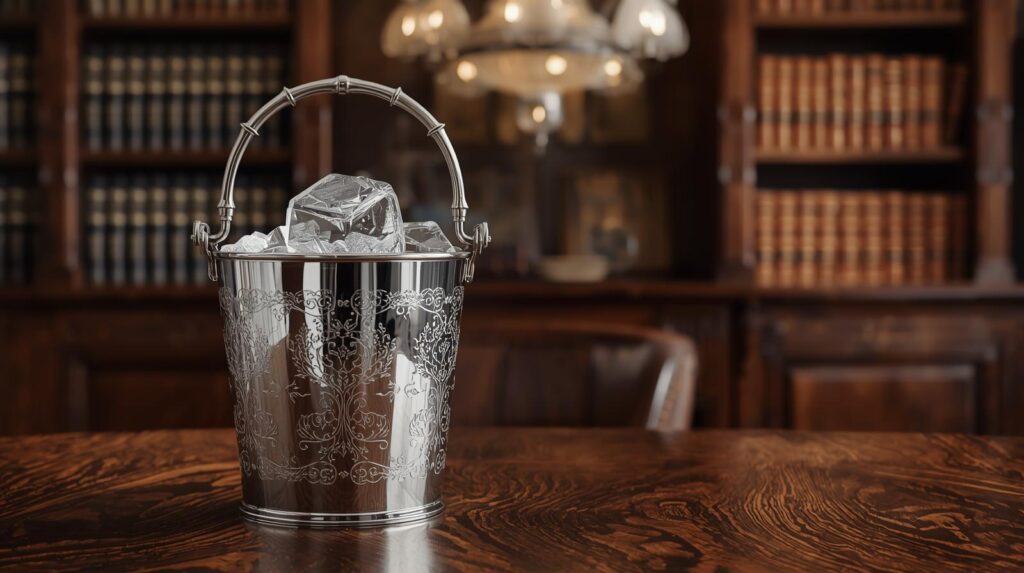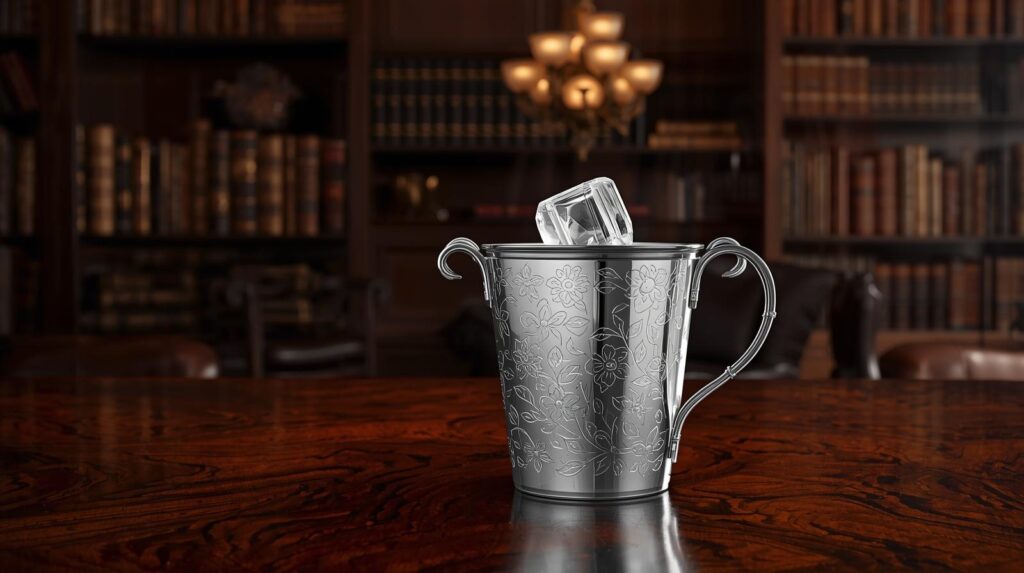Picture this: you reach for a drink on a sweltering afternoon, only to find your ice cubes have surrendered to a pool of lukewarm water. You’ve probably eyed that shiny ice bucket at a party and wondered—does it really keep ice colder for longer, or is it just for show? The chill of anticipation, the clink of cubes against metal, the promise of a refreshingly cold sip—there’s something almost magical about it.
But before you trust your next celebration to an ice bucket, let’s dig into what in reality happens inside that frosty container. You might be surprised by the science—and a few clever tricks—that can turn an ordinary gathering into a cool, unforgettable experience.

What Are Ice Buckets?
Ice buckets keep chilled drinks accessible at parties, picnics, and bars. Insulated ice buckets, for example, slow melting by limiting heat transfer, using materials like stainless steel or double-walled acrylic. Decorative ice buckets add flair, while non-insulated varieties—often found at casual gatherings—warm up faster and leave you with more water than ice.
Serving drinks with an ice bucket on a humid day, you notice how condensation collects, sometimes soaking through party napkins before the fun even starts. Some hosts recall frantic dashes for more ice during summer barbecues when a thin plastic bucket couldn’t handle the triple-digit heat.
Restaurants and hotels routinely use sturdy, lidded ice buckets, not just for aesthetics but for function, aiming to minimize staff interruptions for ice refills during service. Vintage ads from the 1950s promoted ice buckets as symbols of hospitality and modernity, suggesting an enduring role in entertaining—much like a trusty sidekick, always on standby to keep things cool.
Modern ice buckets range from compact six-cup models used on picnic blankets to commercial-grade bins holding 50 pounds or more—helping you tailor cold storage for a romantic rooftop toast or a crowded wedding. In each context, the core idea remains: to stop ice from melting too quickly and keep refreshments cold when it counts most.
How Ice Buckets Work
Ice buckets keep drinks cold by limiting heat transfer, slowing the melting of ice. Their design and material influence how well they preserve chilled temperatures during social gatherings.
The Science of Insulation
Insulation in ice buckets reduces the movement of heat from the surrounding air into the bucket, keeping ice solid longer. Insulated ice buckets, like vacuum-sealed stainless steel models, trap air within their double walls, creating a barrier against ambient heat. Non-insulated buckets, made of plastic or metal without extra layers, transfer outside warmth faster, melting ice in under an hour in temperatures above 75°F. Data from a 2022 Consumer Reports test show insulated buckets kept ice for up to 6 hours, compared to 2 hours with single-wall containers. Examples include YETI Rambler and OXO Good Grips, both designed for households seeking reliable cooling during parties or picnics.
Types of Ice Buckets
Ice buckets fall into distinct categories, each built for a specific context.
- Insulated ice buckets: Double-walled metal or acrylic, these models often appear at weddings or pool parties where guests want drinks to stay cold for hours.
- Non-insulated ice buckets: Thin plastic or single-layer metal, these buckets serve quick gatherings or casual use, such as tailgates or children’s birthday parties.
- Commercial ice bins: Large-capacity stainless steel containers used in restaurants, bars, and hotel lounges; staff refill drinks efficiently, even in crowded venues.
- Decorative ice buckets: Vintage glass or ornamental ceramic, these options combine aesthetics and function for formal dinners or holiday celebrations.
Each bucket style matches a different scenario, from intimate rooftop gatherings to busy banquet halls. Whether you reach for a sleek, insulated design or a classic cut-glass bucket, the choice shapes how long your guests enjoy cold refreshment.
Factors That Affect Ice Retention
Ice retention in buckets relies on a blend of design features and environmental surroundings. Knowing these factors lets you choose an ice bucket that keeps your drinks consistently cold, even during extended events.
Material and Construction
Material and construction stand as key variables in ice retention. Insulated stainless steel buckets—such as those with vacuum-sealed double walls—trap cold air and block ambient heat, according to industry tests like Consumer Reports (2022). Plastic buckets with insulated liners also slow melting, though less effectively than stainless steel. Non-insulated plastic or glass buckets allow heat in quickly and cause melt within 2 hours at room temperature, based on user reviews and comparative demonstrations. Sturdy lids help lock in chill, preventing warm air and humidity from accelerating ice loss. For frequent entertainers, commercial-grade options with reinforced exteriors protect against heat and dents, which extends cooling times for large ice loads.

Environmental Conditions
Environmental conditions dramatically impact ice bucket performance. High outdoor temperatures, direct sun, and humid air increase heat transfer, melting ice rapidly. Shade and moderate conditions extend ice life, as seen during cool evening gatherings compared to backyard barbecues on 90°F days. Air movement around the bucket hastens sublimation and melting, so placing a bucket indoors or away from breezy patios increases retention. If you position buckets near grills, warm appliances, or crowded areas, your ice disappears much faster than when kept in cool corners. Real-world tests reported at summer weddings and picnics show insulated buckets lasting 4–6 hours in controlled shade, while exposed buckets lose ice in under 90 minutes.
Pros and Cons of Using Ice Buckets
Ice buckets offer reliable cooling and immediate access to cold drinks, yet they don’t always solve every party’s warm drink problem. Use them right, and you keep the fizz in your sodas and the chill in your wine; use them wrong, and you might find a puddle where your ice once sat.
Advantages for Parties and Events
Insulated ice buckets extend the lifespan of your ice, letting guests enjoy crisp drinks for up to 6 hours during indoor events or shaded gatherings (Consumer Reports, 2022). Stainless steel models with double walls trap cold air, turning a chaotic mid-party ice run into a non-issue. Picture refilling glasses at a summer birthday or an outdoor wedding—an insulated, lidded bucket lets you focus on conversations instead of chasing down more ice.
Restaurants and caterers opt for larger, commercial bins that serve entire banquet halls without constant refills. You’ll spot decorative glass or hammered steel buckets on hotel banquet tables, blending elegance with efficiency. Vintage hosts in the 1950s flaunted cut-crystal buckets, their guests marveling at the host’s resourcefulness and hospitality when they still had chilled cocktails after an hour of laughter and storytelling. For busy hosts today, a well-chosen ice bucket anchors your drink station and keeps the celebration on track.
Limitations and Challenges
Ice buckets struggle when you expose them to direct sun or place them in humid environments. Uninsulated models melt ice quickly—Consumer Reports tests showed a loss of solid ice in under 2 hours on a 78°F patio. Lids help, but even an insulated bucket can’t defy a long, hot afternoon. Uninsulated options often need multiple refills, breaking up the rhythm of your event.
Transporting and cleaning large or commercial bins presents another hassle, especially after outdoor parties in muddy or sandy spots. Decorative ice buckets sometimes prioritize looks over performance; glass warms quickly under overhead lights, and artistic finishes may be prone to chips or cracks. Consider your space—on a cramped dinner table, oversized buckets crowd out glassware, so compact models work best.
If your gathering stretches all day or transitions from indoors to outside, even the best bucket can’t compete with a portable cooler or built-in ice maker. Think through your event’s timing, climate, and guest count, choosing the option that combines durability with chill.
Alternatives to Ice Buckets
Ice packs deliver steady chill for cans or bottles when you stack them around drinks in a sturdy cooler. You might’ve noticed gel packs staying firm even as the party heats up—unlike ice cubes that vanish in a puddle hours before dessert arrives. Place gel cold packs under and over your drinks, if you like, then snap the cooler lid tight for maximum effect. Yakima-based beverage caterers, for example, pack folding coolers with ice packs for outdoor weddings to avoid the drippy mess of half-melted cubes.
Insulated cooler bags combine portability with extended cold retention, proving handy at picnics and short beach trips. Unlike ice buckets, you can zip cooler bags shut and sling them over your shoulder. Twenty-four can cooler totes, like Arctic Zone Titan, keep drinks under 40°F for about 8 hours according to 2023 field tests from Good Housekeeping. You can bring leftover drinks home still cold—try that with a classic party bucket.
Wine chill sleeves wrap snugly around bottles, instantly lowering their temperature without condensation soaking tablecloths. You might reach for a Vacu Vin sleeve during a dinner where you care more about the flavor than the show—“trading the ice bucket’s flair for silent precision,” as one sommelier put it. These sleeves freeze overnight and slip on just before serving, keeping white or rose wine crisp all meal long.
Refrigerated beverage dispensers, common at upscale bars, maintain icy temperatures for hours with built-in cooling cores. Hosts who prefer precision over tradition opt for these plugged-in solutions, especially for cocktail bars or patio brunches. At the 2022 Home Entertaining Expo, mixologists shared how clear dispensers with integrated chill tubes prevented watered-down sangria even on muggy afternoons.
Reusable stainless steel ice cubes offer a minimalist, mess-free way to chill spirits—ideal for whiskey tastings or solo porch sunsets. You probably wouldn’t chill a whole punch bowl this way, but a set of eight cubes chilled in your freezer delivers that arctic bite without dilution. Bartenders at Chicago’s Pilsen Yards swap these in on slow summer nights, sparing guests from the disappointment of a watery Negroni.
If you crave that crackle and spectacle, dry ice turns heads as a dramatic cooling method for punch bowls or soda at Halloween parties. Dry ice, but, demands caution—don’t touch it barehanded or seal it in airtight containers. Restaurateur Pamela Chang once turned a dry ice mishap into a safety PSA live on her Instagram, recounting how frosty fog poured down her counter, children delighted and adults scrambling for gloves.
Would you rather skip cooling altogether? Some hosts pivot, buying pre-chilled drinks in bulk and displaying them on stone or marble trays—turning temperature into décor. At a Kansas City gallery open house, guests relished frosty bottles nestled on slab granite, “as cold and inviting as fresh quarried rock,” the owner remarked. Maybe the ice bucket’s only rival is an idea you invent yourself—what cold trick would you try at your next gathering?
Conclusion
Choosing the right ice bucket can make a big difference in how long your drinks stay cold and how smoothly your event runs. Whether you’re hosting a backyard barbecue or a formal dinner party you’ve got plenty of options to fit your needs and style.
Think about your event’s setting and how long you’ll need to keep drinks chilled. With the right setup you’ll keep guests happy and avoid the hassle of constant refills. If you want to get creative there are also plenty of smart alternatives that can help you serve perfectly chilled drinks every time.
